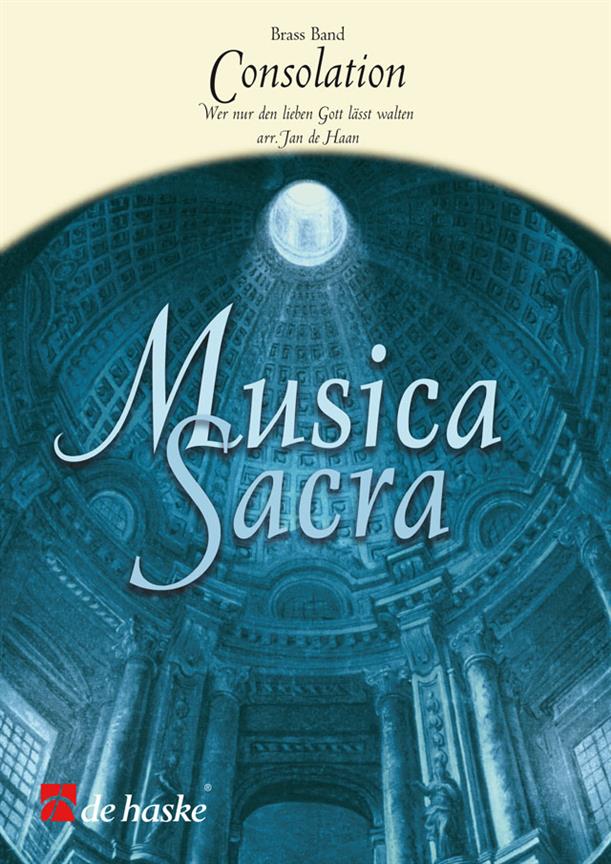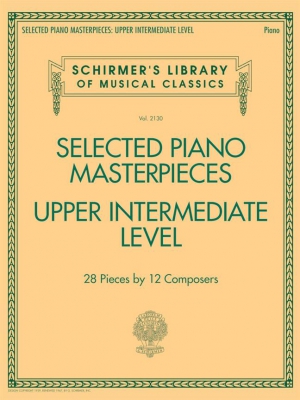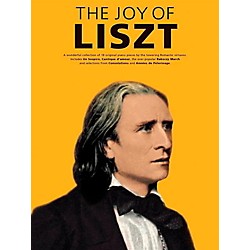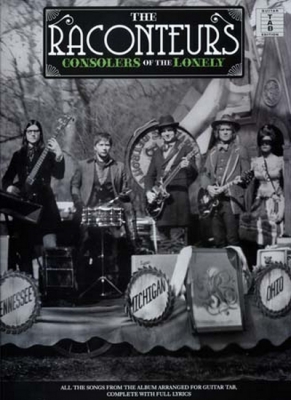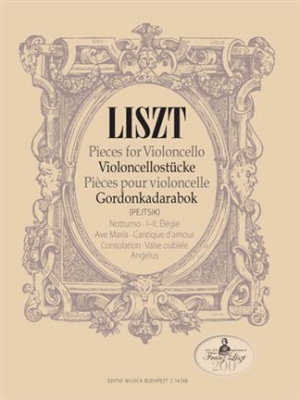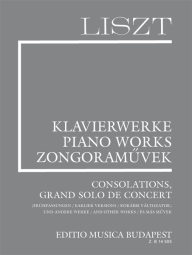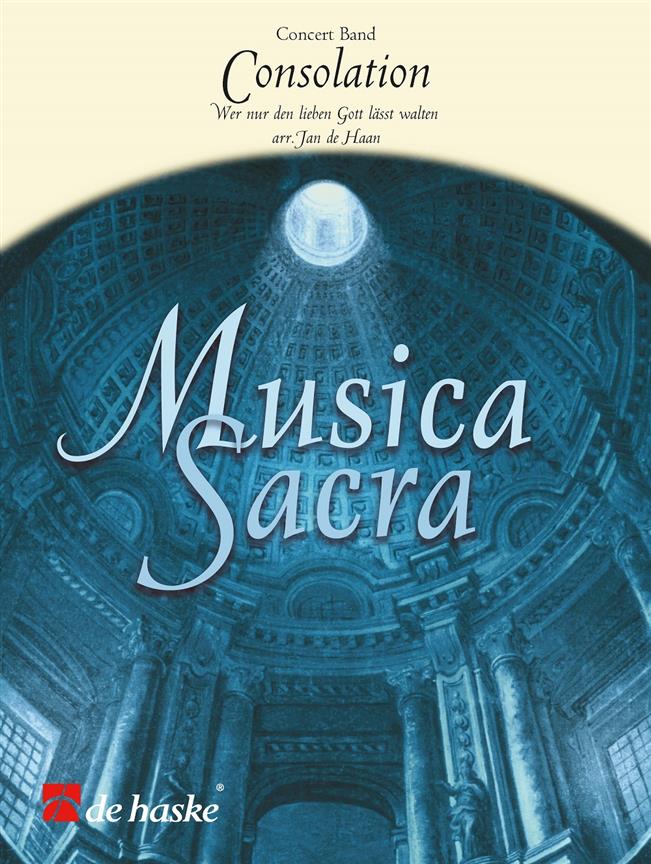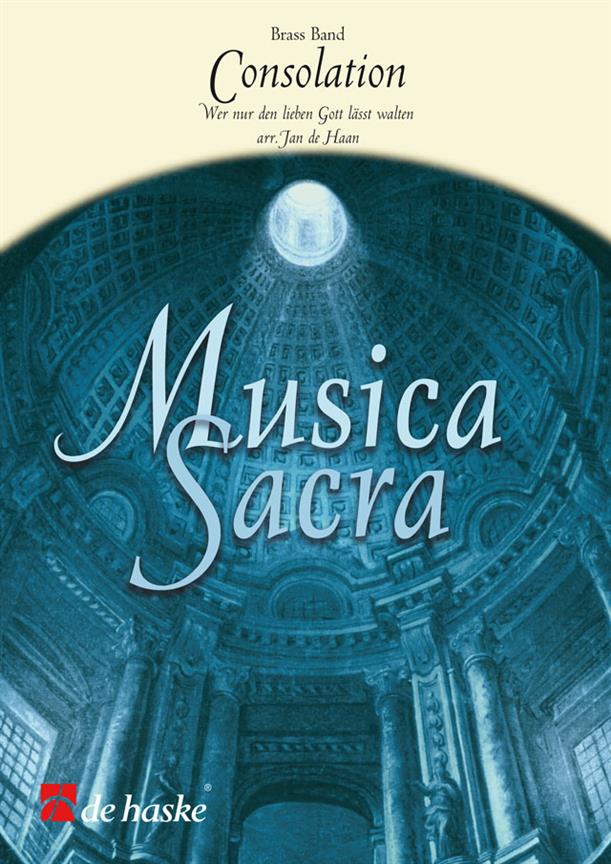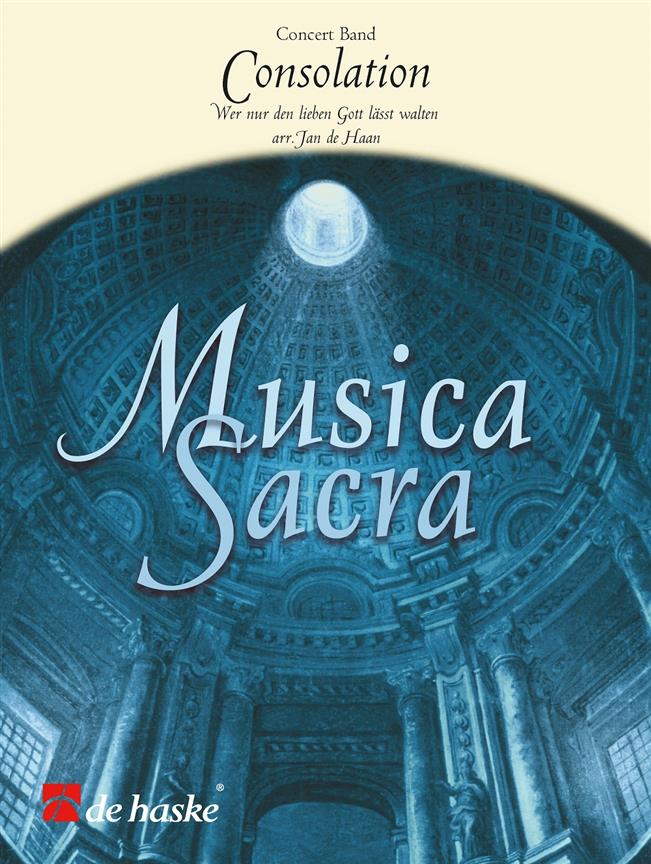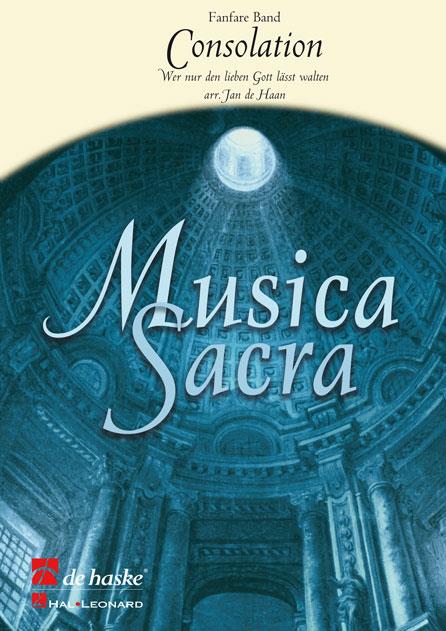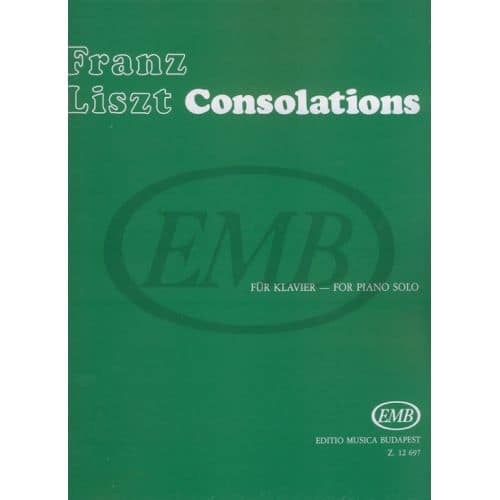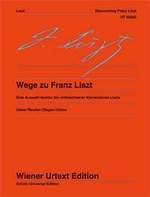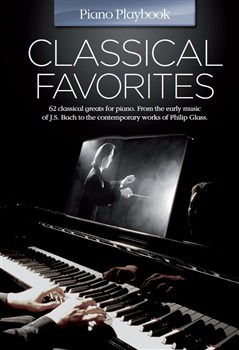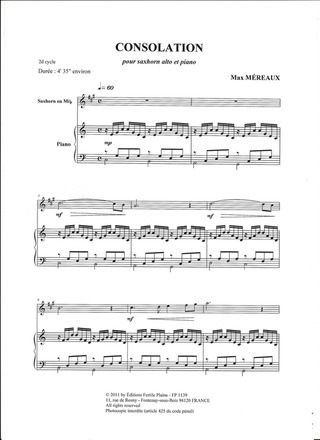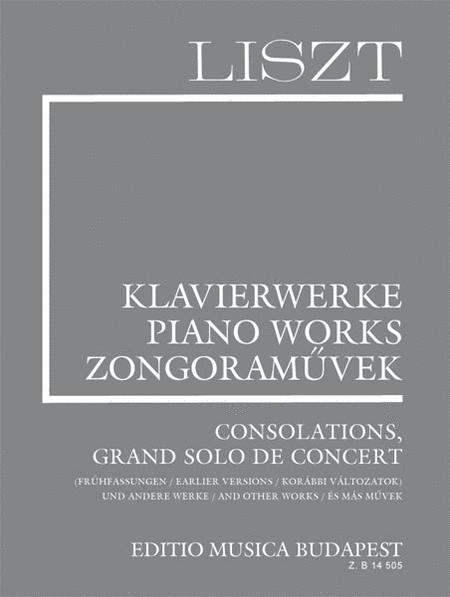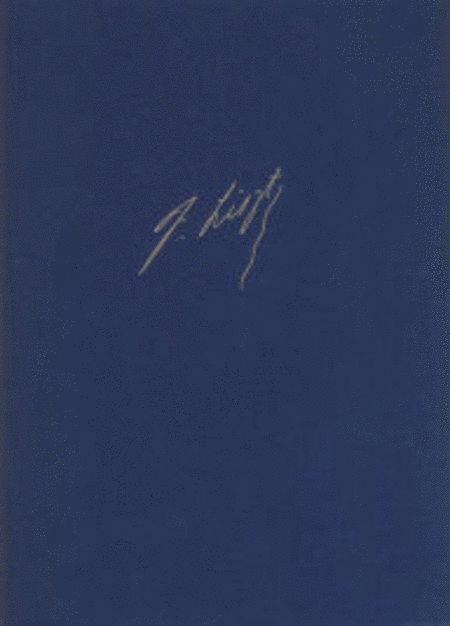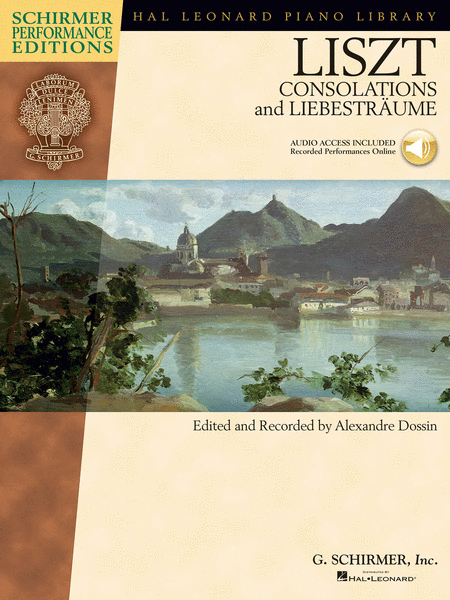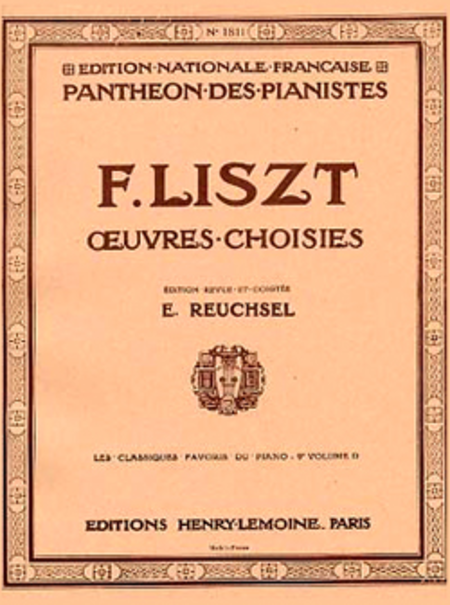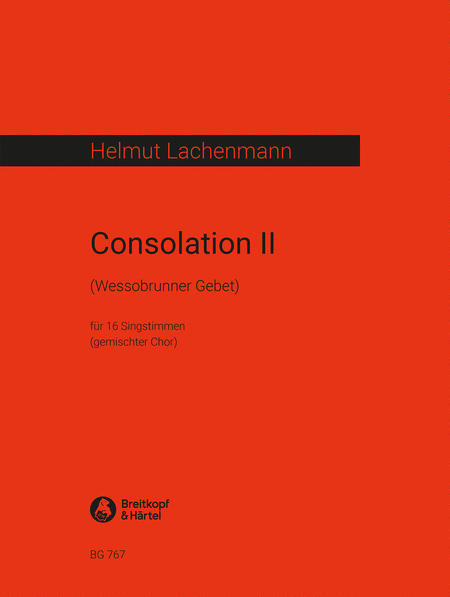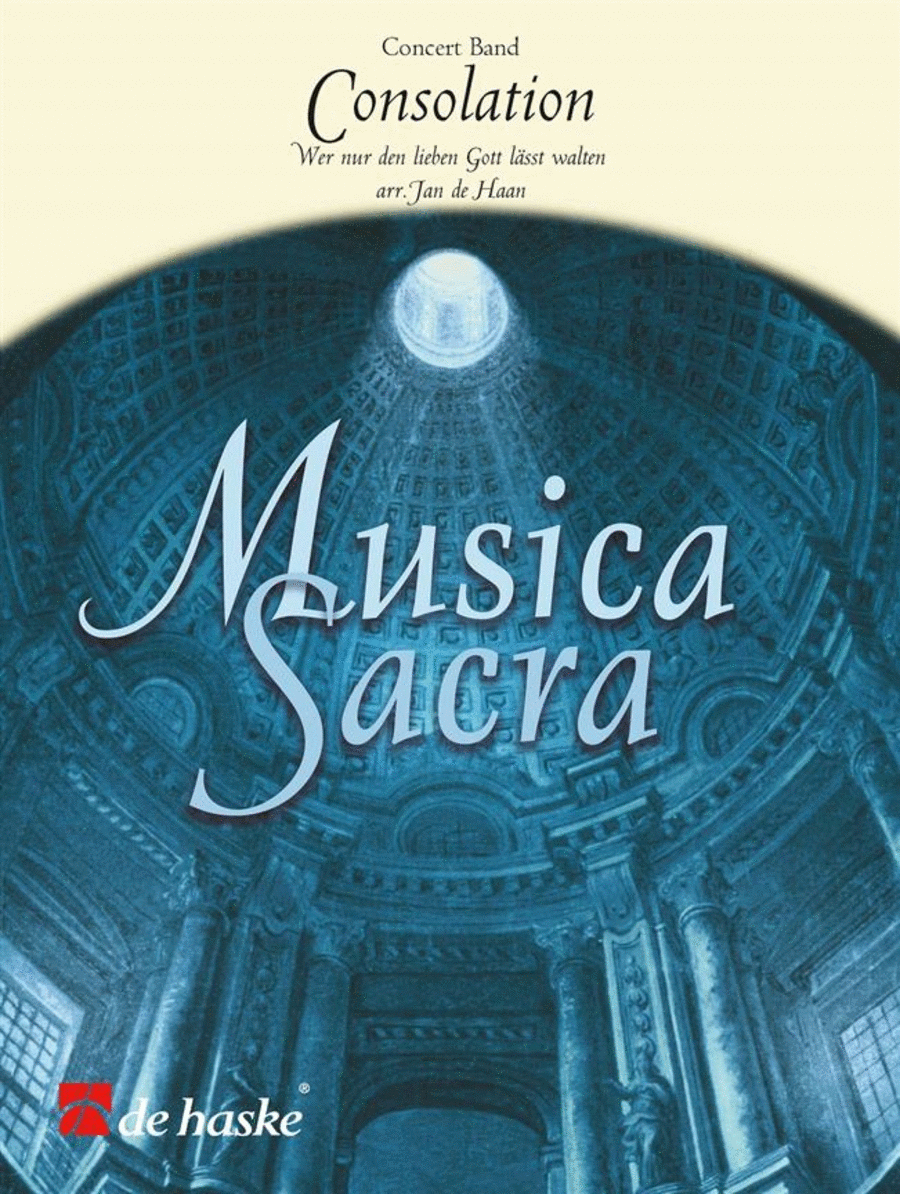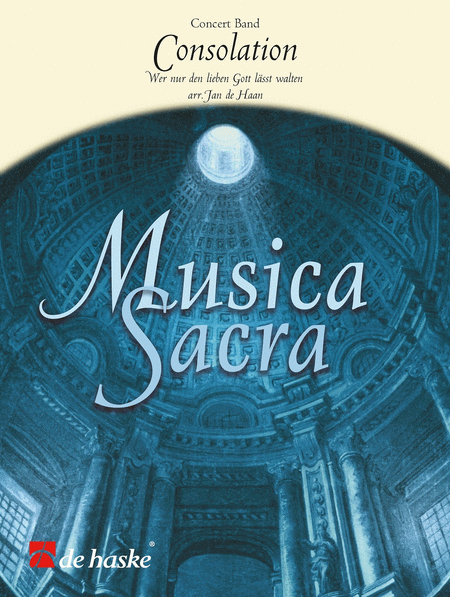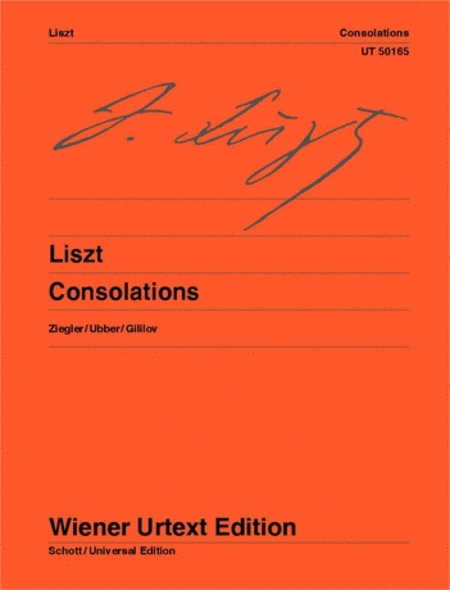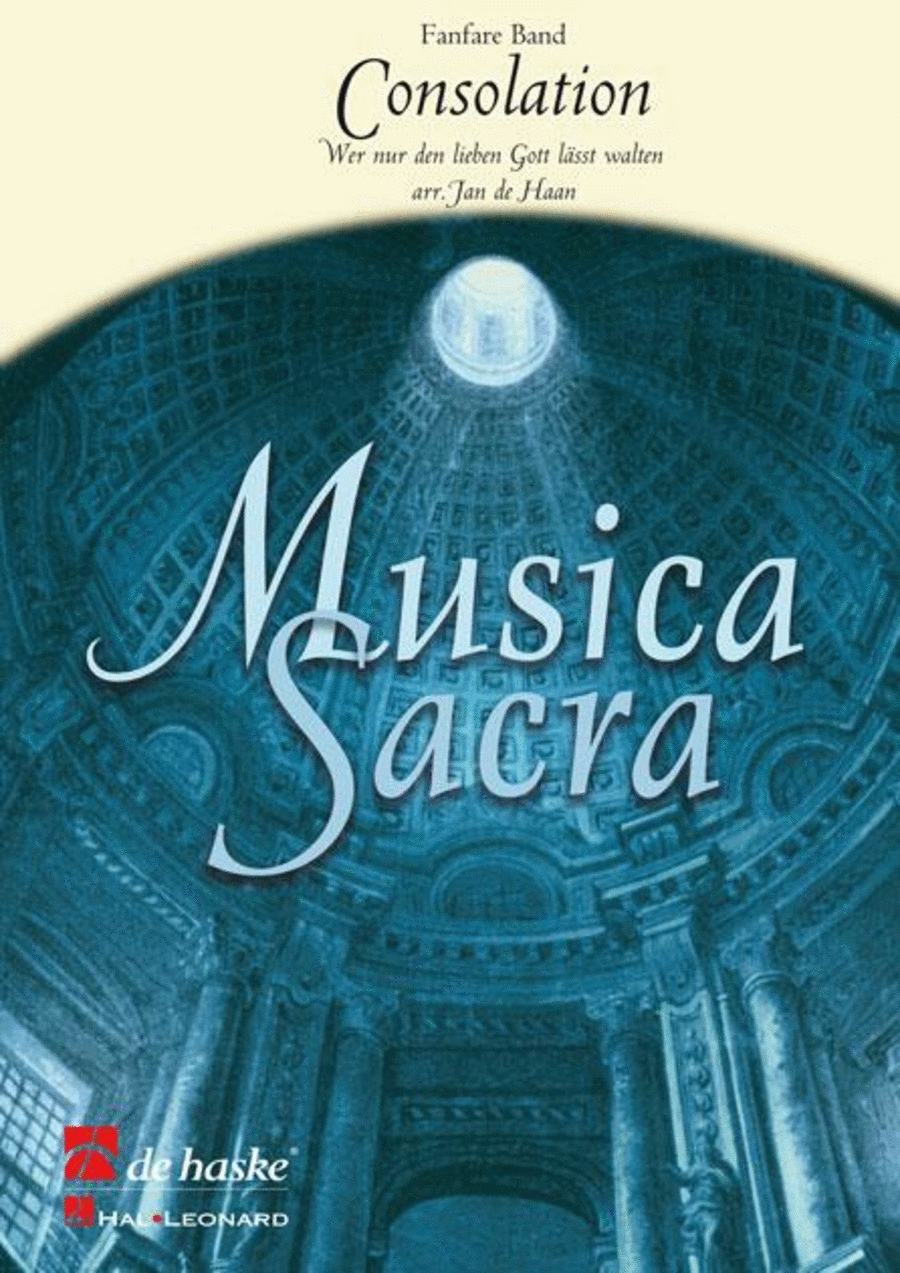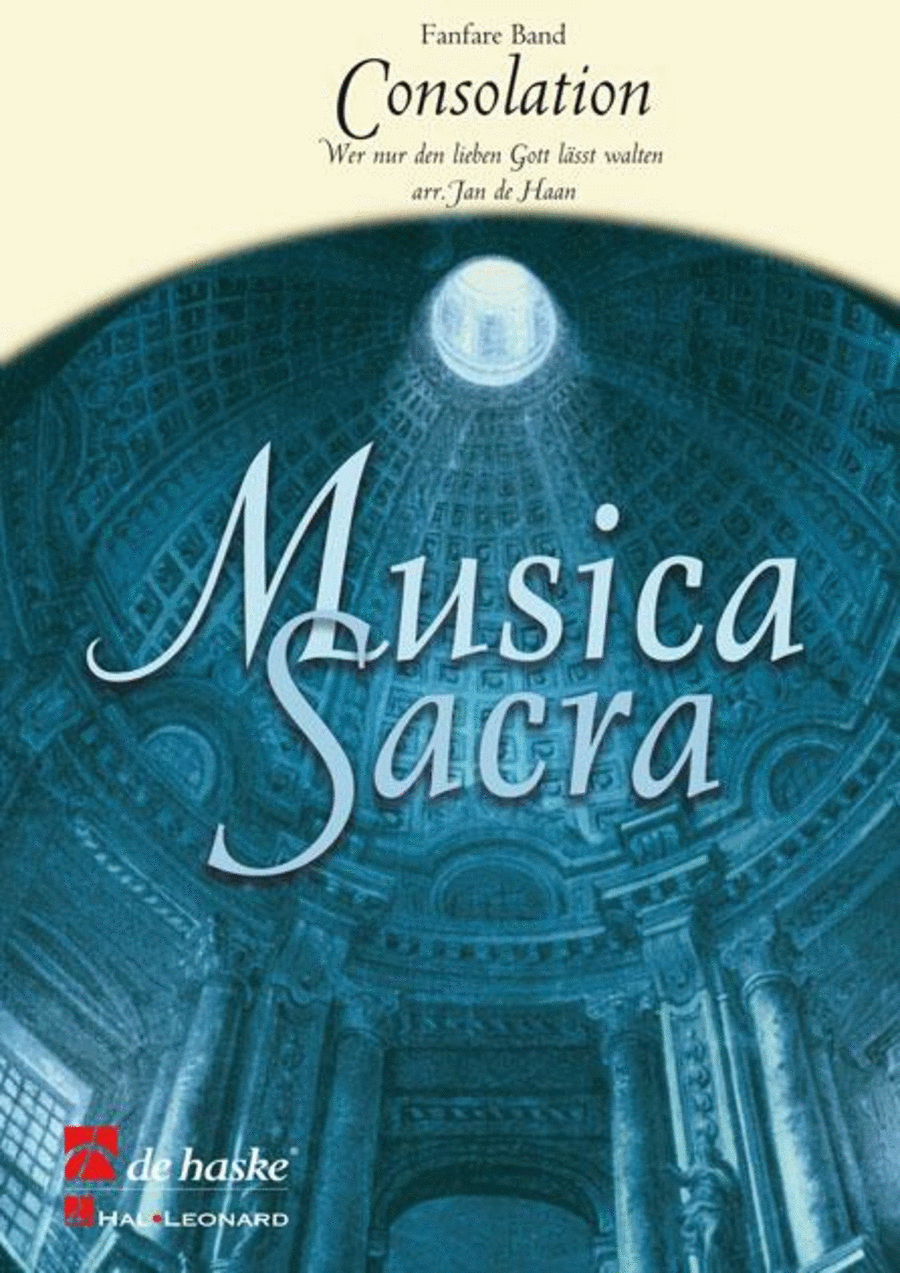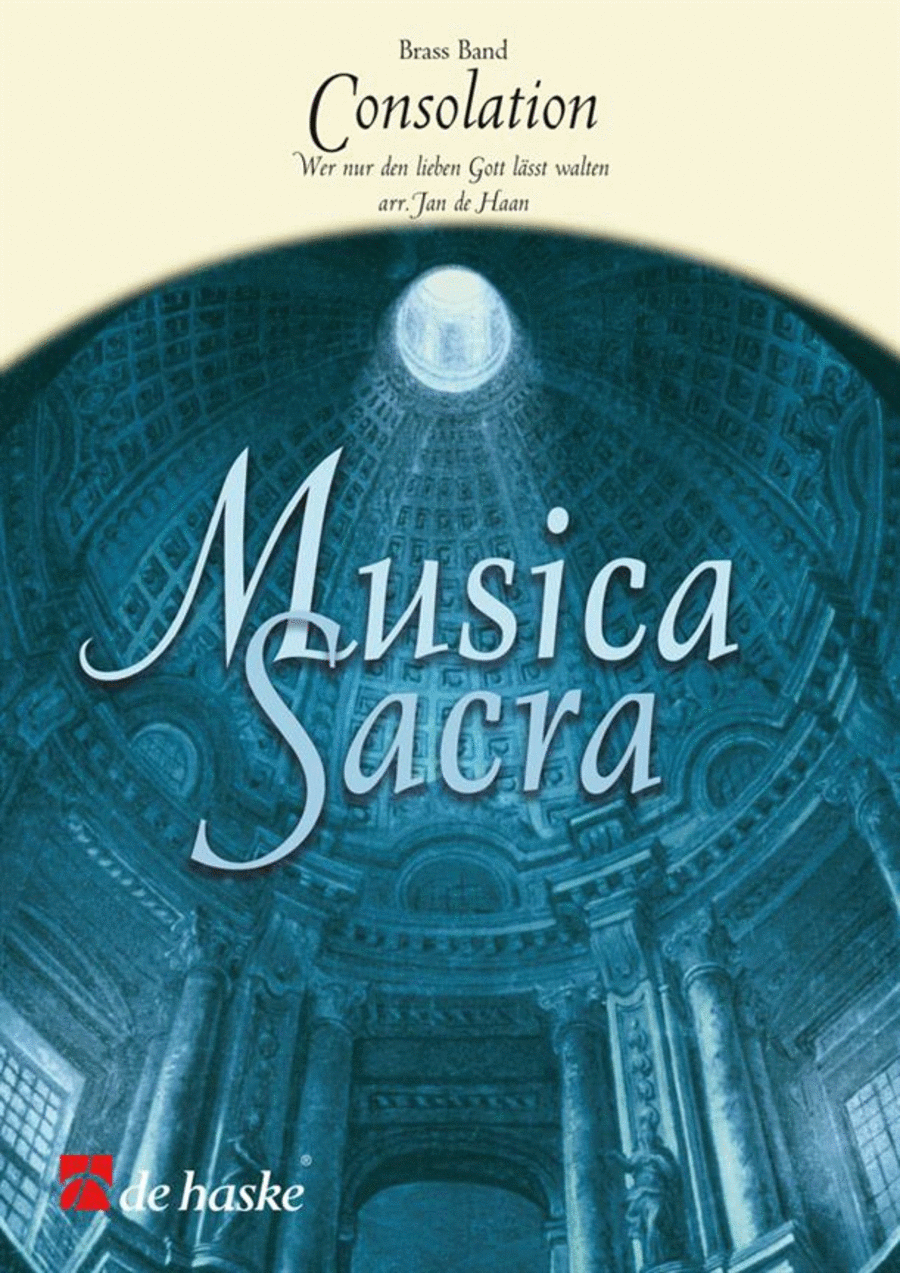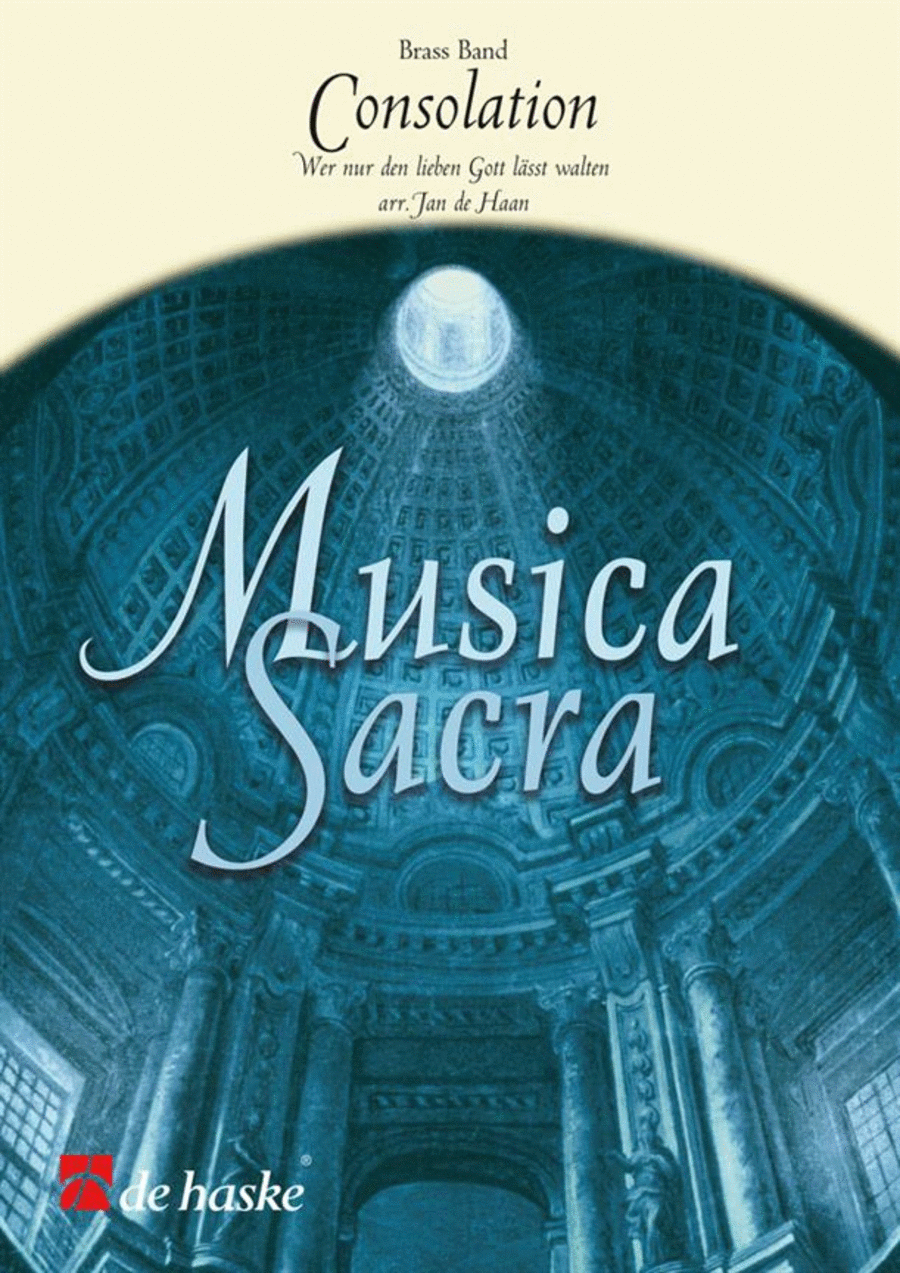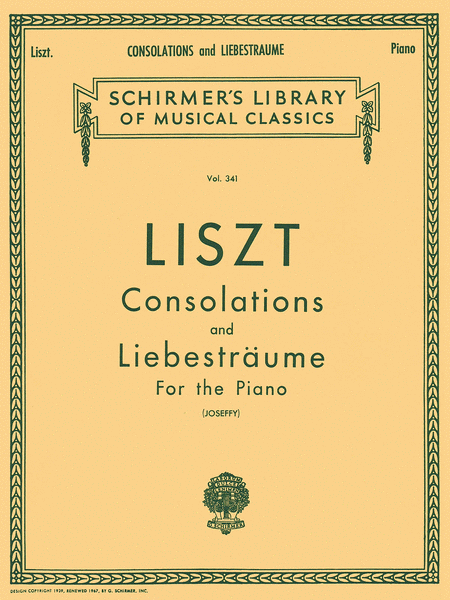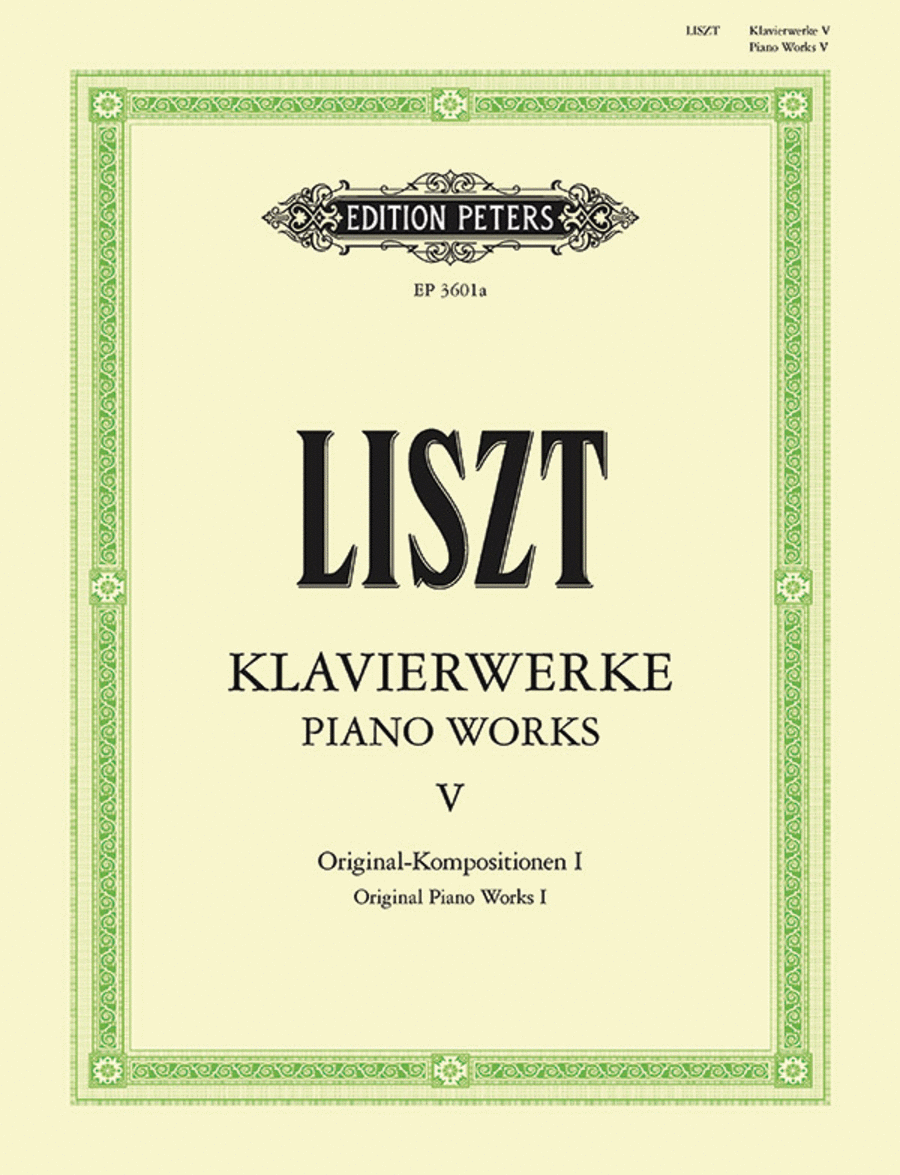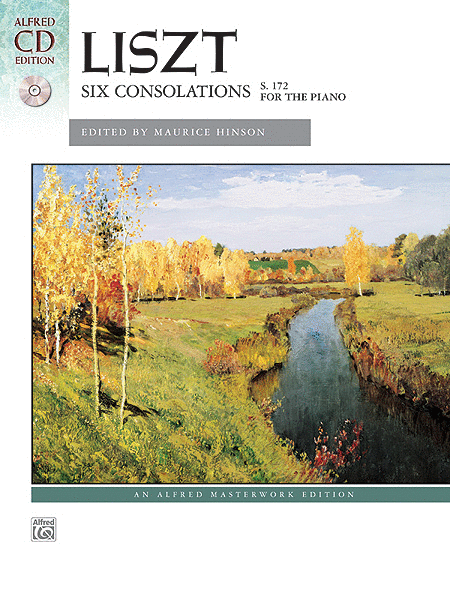|
| Selected Piano
Masterpieces - Upper
Intermediate
Piano seul [Partition]
Schirmer
28 pieces by JS Bach, Bartók, Chopin, Debussy, Grieg, Liszt, Mendelssohn, Satie...(+)
28 pieces by JS Bach, Bartók, Chopin, Debussy, Grieg, Liszt, Mendelssohn, Satie, Schubert, Schumann, Scriabin, and Tchaikovsky. All are at the upper intermediate level in a slim, affordable volume. Includes - JS BACH: Prelude in D minor, BWV 935 - BARTÓK: Bear Dance from Ten Easy Pieces - CHOPIN: Prélude in D-flat Major Raindrop, Op. 28, #15 - Waltz in B minor, Op. 69, #2 (Posthumous) - DEBUSSY: Doctor Gradus ad Parnassum from Children's Corner - Rèverie - GRIEG: March of the Trolls from Lyric Pieces, Op. 54, #3 - LISZT: Consolation #3 from Consolations, MENDELSSOHN: Song Without Words in F-sharp minor, Venetian Boat-Song #2, Op. 30, #6 - SATIE: Three Gymnopédies - SCHUBERT: Moment musical in A-flat Major from Six moments musicaux, Op. 94, #2 / Piano
Délais: 2-5 jours - En Stock Fournisseur | | |
| The Joy Of Liszt
Piano seul
Amsco Wise Publications
The Joy Of Liszt is a wonderful collection of 18 original Piano pieces by the to...(+)
The Joy Of Liszt is a wonderful collection of 18 original Piano pieces by the towering Romantic virtuoso.This book includes the pieces Un Sospiro, Cantique 'd'amour, the ever-popular Rakoczy March and selections from Consolations and Années de Pèlerinage. / Piano
Délais: 2-5 jours - En Stock Fournisseur | | |
| Raconteurs Consolers Of
The Lonely
Guitare notes et tablatures [Partition]
Amsco Wise Publications
Guitar Tab edition of Consolers Of The Lonely the second album by the Raconteurs...(+)
Guitar Tab edition of Consolers Of The Lonely the second album by the Raconteurs. This matching folio conatains all songs from the album arranged for Guitar TAB, complete with full lyrics. / Guitare
Délais: 2-5 jours - En Stock Fournisseur | | |
| Pieces For Violoncello
Violoncelle, Piano
EMB (Editio Musica Budapest)
Peu de gens savent que Franz Liszt organisé certaines de ses pièces pour piano...(+)
Peu de gens savent que Franz Liszt organisé certaines de ses pièces pour piano pour le violoncelle, avec accompagnement de piano, et cette version de l'oeuvre apparu dans d'impression pendant la durée de vie du maestro. Árpád Pejtsik sélectionné deux de ces volumes pour cette compilation d'jubilé marque de Liszt: Elégies I et II Les autres compositions de Liszt qui apparaissent dans la collection ont été également à l'origine pour des oeuvres pour piano: l'Ave Maria et Cantique d'amour (des pièces de la Harmonies poétiques et religieuses de cycle) ont été transcrites par un élève de Liszt, Robert Pflughaupt, la version pour violoncelle, transposée en sol majeur, de la Consolation E Major est par Jules de Swert, violoncelliste solo à l'orchestre de Weimar de ces jours, celle de l'Angélus (le morceau d'ouverture dans le tome 3 du cycle intitulé Années de Pèlerinage) est par Lothar Windsperger, un compositeur qui vivait Deutsch au tournant du siècle 19ème-20ème. / Violoncelle Et Piano
Délais: 2-5 jours - En Stock Fournisseur | | |
| Consolations, Grand Solo
Concert (Hard)
Piano seul [Partition]
EMB (Editio Musica Budapest)
Suppl. 10. Par LISZT FRANZ. Of the early versions of works included in Supplemen...(+)
Suppl. 10. Par LISZT FRANZ. Of the early versions of works included in Supplementary Volume 10, particular interest is expected in the first versions of the notably popular Consolations cycle and the monumental Grand solo de concert of 1850. In the first version of Consolationsthe third movement was a style hongrois piece whose thematic material Liszt used again later in the first piece of the Hungarian Rhapsodies published in 1851. The first version of the Grand solo de concert shows that the original concept did notinclude the slow “movement” that would be placed in the middle of the work and recapitulated towards the end in the final version - a characteristically Lisztian feature that would reappear a few years later in the Sonata in B flat minor. A detailed preface in Hungarian, English and German, including new research results, numerous manuscript facsimiles and critical notes make this volume of the New Liszt Edition a specially important publication of scholarly value. Simultaneously withthe Complete Edition volume in colth-bound, its paperback for practical purposes is also published, the contents of which, except for the critical notes, is identical with the Complete Edition volume./ Répertoire / Piano
Délais: 2-5 jours - En Stock Fournisseur | | |
| Consolation
Orchestre d'harmonie [Conducteur et Parties séparées] - Intermédiaire
De Haske Publications
Wer nur den lieben Gott lässt walten. Vers 1641, Georg Neumark compose l’hymn...(+)
Wer nur den lieben Gott lässt walten. Vers 1641, Georg Neumark compose l’hymne chrétienne Wer nur den lieben Gott lässt walten, dont chacune des sept strophes exprime sa foi en Dieu. Il lui donne le soustitre Chant de consolation. Dans cet arrangement de Jan de Haan, le choral est exposé à deux reprises : d’abord précédé d’une courte introduction suivie d’une variation entre chaque vers, puis dans une trame continue qui, fidèle au sous-titre original, cherche dans son action la consolation. / Niveau : 3 / Hymnes et chorals / Recueil / Concert Band ou Harmonie
Délais: 2-5 jours - En Stock Fournisseur | | |
| Consolation
Fanfare [Conducteur et Parties séparées] - Intermédiaire
De Haske Publications
Wer nur den lieben Gott lässt walten. Wer nur den lieben Gott lässt walten was...(+)
Wer nur den lieben Gott lässt walten. Wer nur den lieben Gott lässt walten was composed by Georg Neumark in about 1641 and was subtitled ‘Trostlied’ literally meaning consolation song. Songbooks at the time showed the popularity of this song and it is still well-known today partly due to Johann Sebastian Bach’s use of the melody for one of his own chorals. In Jan de Haan’s arrangement the choral is heard twice, once, alternating with the original motif from the introduction and a second time, without interruption, reflecting the composer’s original intention - a song of consolation. / Niveau : 3 / Hymnes et chorals / Recueil / Fanfare
Délais: 2-5 jours - En Stock Fournisseur | | |
| Consolation
Ensemble de cuivres [Conducteur et Parties séparées] - Intermédiaire
De Haske Publications
Wer nur den lieben Gott lässt walten. Wer nur den lieben Gott lässt walten was...(+)
Wer nur den lieben Gott lässt walten. Wer nur den lieben Gott lässt walten was composed by Georg Neumark in about 1641 and was subtitled ‘Trostlied’ literally meaning consolation song. Songbooks at the time showed the popularity of this song and it is still well-known today partly due to Johann Sebastian Bach’s use of the melody for one of his own chorals. In Jan de Haan’s arrangement the choral is heard twice, once, alternating with the original motif from the introduction and a second time, without interruption, reflecting the composer’s original intention - a song of consolation. / Niveau : 3 / Hymnes et chorals / Recueil / Brass Band
Délais: 2-5 jours - En Stock Fournisseur | | |
| Consolation
Ensemble de cuivres [Conducteur] - Intermédiaire
De Haske Publications
Wer nur den lieben Gott lässt walten. Wer nur den lieben Gott lässt walten was...(+)
Wer nur den lieben Gott lässt walten. Wer nur den lieben Gott lässt walten was composed by Georg Neumark in about 1641 and was subtitled ‘Trostlied’ literally meaning consolation song. Songbooks at the time showed the popularity of this song and it is still well-known today partly due to Johann Sebastian Bach’s use of the melody for one of his own chorals. In Jan de Haan’s arrangement the choral is heard twice, once, alternating with the original motif from the introduction and a second time, without interruption, reflecting the composer’s original intention - a song of consolation. / Niveau : 3 / Hymnes et chorals / Recueil / Brass Band
Délais: 2-5 jours - En Stock Fournisseur | | |
| Consolation
Orchestre d'harmonie [Conducteur] - Intermédiaire
De Haske Publications
Wer nur den lieben Gott lässt walten. Vers 1641, Georg Neumark compose l’hymn...(+)
Wer nur den lieben Gott lässt walten. Vers 1641, Georg Neumark compose l’hymne chrétienne Wer nur den lieben Gott lässt walten, dont chacune des sept strophes exprime sa foi en Dieu. Il lui donne le soustitre Chant de consolation. Dans cet arrangement de Jan de Haan, le choral est exposé à deux reprises : d’abord précédé d’une courte introduction suivie d’une variation entre chaque vers, puis dans une trame continue qui, fidèle au sous-titre original, cherche dans son action la consolation. / Niveau : 3 / Hymnes et chorals / Recueil / Concert Band ou Harmonie
Délais: 2-5 jours - En Stock Fournisseur | | |
| Consolation
Fanfare [Conducteur]
De Haske Publications
Wer nur den lieben Gott lässt walten. Wer nur den lieben Gott lässt walten was...(+)
Wer nur den lieben Gott lässt walten. Wer nur den lieben Gott lässt walten was composed by Georg Neumark in about 1641 and was subtitled ‘Trostlied’ literally meaning consolation song. Songbooks at the time showed the popularity of this song and it is still well-known today partly due to Johann Sebastian Bach’s use of the melody for one of his own chorals. In Jan de Haan’s arrangement the choral is heard twice, once, alternating with the original motif from the introduction and a second time, without interruption, reflecting the composer’s original intention - a song of consolation. / Hymnes et chorals / Recueil / Fanfare
Délais: 2-5 jours - En Stock Fournisseur | | |
| Liszt Franz -
Consolations - Piano
Piano seul
EMB (Editio Musica Budapest)
CONSOLATIONS (SIX PENSÉES POÉTIQUES) PUBLIÉ PAR SULYOK IMRE, MEZ' IMRE INSTR...(+)
CONSOLATIONS (SIX PENSÉES POÉTIQUES) PUBLIÉ PAR SULYOK IMRE, MEZ' IMRE INSTRUMENT: PIANO SÉRIE: LISZT SEPARATE EDITIONS GENRE: ROMANTIC PAGES: 16 PP DATE DU PARUTION: 1984
Délais: Sur commande | | |
| Consolations
 En Français En Français
Piano seul [Recueils et oeuvres séparées]
Billaudot
La partition CONSOLATIONS est une oeuvre du compositeur Classique Liszt Franz. C...(+)
La partition CONSOLATIONS est une oeuvre du compositeur Classique Liszt Franz. Cette partition musicale est éditée par une des nombreuses maisons d'édition française à savoir Billaudot. Cette oeuvre musicale fait partie intégrante des oeuvres de style Classique. / Divers / Partition
Délais: 2-5 jours - En Stock Fournisseur | | |
| Pathways To Franz Liszt
Piano seul
Wiener Urtext
Le fait que les oeuvres pour piano de Franz Liszt nécessitent pas toujours les ...(+)
Le fait que les oeuvres pour piano de Franz Liszt nécessitent pas toujours les normes techniques les plus élevées ou sont réputés être réservée à quelques professionnels est prouvé par la présente anthologie de la Wiener Urtext Edition. Il comprend des oeuvres de Liszt qui, à partir d'un niveau facile à intermédiaire technique, encouragent à jouer, plutôt que par des harmoniques par les exigences virtuoses, et permettent encore de faire des progrès dans la technique de jeu qui finalement est bénéfique non seulement pour jouer Liszt. La sélection, allant de pièces faciles comme La cloche sonne ou les Consolations n o 1 et 2 à des oeuvres plus avancées telles que 'Au lac de Wallenstadt 'de' Années de Pèlerinage ', prend également l'aspect de popularité dans le cadre de Liszt littérature pianistique en compte. / Piano
Délais: En Stock | | |
| Piano Playbook Classical
Favourites P/V/G
Piano seul - Avancé
Amsco Wise Publications
Compilations regroupant les plus grands titres d'un genre musical spécialement ...(+)
Compilations regroupant les plus grands titres d'un genre musical spécialement regravées en piano, voix et diagrammes d'accord guitare ou en piano solo en format A4 spiralé afin qu'il reste 'plat' sur le support du piano.Titres : Miserere mei, Deus [Allegri] - Sarabande [Arnold, Malcolm] - Aria from Goldberg Variations [Bach, J.S.] - Badinerie (from Orchestral Suite #2 in B Minor) [Bach, J.S.] - Prelude #11 in F Major (from The Well-Tempered Clavier) [Bach, J.S.] - Solfeggietto in C Minor [Bach, C.P.E.] - Symphony #7 - II. Allegretto [Beethoven] - Two Turtle Doves (from Partridge Pie) [Bennett, R.R.] - Prelude #6 (from Six Preludes) [Berkeley, Lennox] - Prelude from L'Arlésienne [Bizet] - Polovtsian Dances (from Prince Igor) [Borodin] - Wiegenlied (Lullaby) [Brahms] - Violin Concerto #1 - II. Adagio [Bruch] - Piano Concerto #1 - II. Larghetto (Romance) [Chopin] - Prelude in C Minor, Op.28 #20 [Chopin] - Waltz in A-flat Major, Op.69 #1 [Chopin] - Les Baricades Mistérieuses [Couperin] - The Little Shepherd (from Children's Corner) [Debussy] - Sarabande [Einaudi, Ludovico] - Snow Prelude #2 [Einaudi, Ludovico] - Nimrod (Var IX from 'Enigma' Variations) [Elgar] - Homenaje (Le Tombeau de Claude Debussy) [de Falla] - Agnus Dei (from Requiem in D Minor, Op.48) [Fauré] - Sicilienne, Op.78 [Fauré] - The North Pole (from Frozen Planet) [Fenton, George] - Prelude #1 (from Three Preludes For Piano) [Gershwin, George] - Metamorphosis Five [Glass, Philip] - Opening Piece from Glassworks [Glass, Philip] - Piano Concerto, Op.16 - I. Allegro Moderato (opening) [Grieg] - Hornpipe (Alla Danza) (from Water Music) [Handel] - Symphony #94 'The Surprise' - II. Andante [Haydn] - Consolation #5 [Liszt] - Paganini Variations (excerpts) [Lutoslawski, Witold] - Hebrides Overture ('Fingal's Cave') [Mendelssohn] - Overture to The Marriage of Figaro [Mozart] - Piano Concerto #21 in C Major - II. Andante [Mozart] - Promenade (From Pictures At An Exhibition) [Mussorgsky] - Big My Secret (from The Piano) [Nyman, Michael] - Jerusalem [Parry] - Sonata For Flute - 2nd Movement [Poulenc] - Mouvements Perpétuels - #1 [Poulenc] - Nessun Dorma (from Turandot) [Puccini] - Rondeau (from Abdelazer) [Purcell] - Piano Concerto #2 - II. Adagio Sostenuto [Rachmaninoff] - Rhapsody on a Theme of Paganini - Var XI and XVIII [Rachmaninoff] - Vocalise (No.14 from Fourteen Songs, Op.34) [Rachmaninoff] - Pavane (from Mother Goose) [Ravel] - Written On The Sky [Richter, Max] - The Elephant (from The Carnival Of The Animals) [Saint-Saëns] - Sonata in E Major, L.23 K.380 [Scarlatti, Domenico] - Unfinished' Symphony - I. Allegro Moderato [Schubert] - Sicilienne (from Album For The Young) [Schumann] - Prelude, Op.11 #15 [D-flat major] [Scriabin] - Romance in D-flat (No.9 from 10 Pieces for Piano, Op.24) [Sibelius] - The Firebird Suite - Finale [Stravinsky, Igor] - The Lamb [Tavener, John] - 1812 Overture [Tchaikovsky] - Dance of the Sugar Plum Fairy (from The Nutcracker Suite) [Tchaikovsky] - Dies Irae (from Requiem) [Verdi] - Autumn (1st movt) (from The Four Seasons) [Vivaldi] - Ride of the Valkyries [Wagner] - Vltava (The Moldau) (from Má Vlast) [Smetena] / Piano/Vocal/Guitare (PVG)
Délais: 2-5 jours - En Stock Fournisseur | | |
| Consolation
 En Français En Français
Tuba ou Euphonium ou Saxhorn [Partition]
Fertile Plaine Editions
Editée au cours de l'exercice 2011-2012 par les éditions Fertile Plaine, la pa...(+)
Editée au cours de l'exercice 2011-2012 par les éditions Fertile Plaine, la partition qui a pour titre Consolation du compositeur Mereaux Max a été cataloguée sous la référence FP 1139 par l'éditeur. Cette oeuvre est écrite pour Tuba, Euphonium ou Saxhorn. En 3 clics et quelques jours elle peut être chez vous. / Tuba, Euphonium ou Saxhorn / Partition
Délais: 2-5 jours - En Stock Fournisseur | |
|
|
|
| Consolations
Piano seul
EMB (Editio Musica Budapest)
Piano SKU: BT.EMBZ14505 Grand solo de concert (earl. vers.) and Other ...(+)
Piano SKU:
BT.EMBZ14505 Grand
solo de concert (earl.
vers.) and Other Works
(Suppl. B 10). By
Adrienne
Kaczmarczyk_Ãgnes Sas.
By Franz Liszt. EMB Liszt
Works. Book Only.
Composed 2014. 208 pages.
Editio Musica Budapest
#EMBZ14505. Published by
Editio Musica Budapest
(BT.EMBZ14505).
English-German-Hungari
an. Of the early
versions of works
included in this volume
the first versions of the
notably popular
Consolations cycle and
Grand solo de concert
(published in 1850) are
of particular interest.
In the first version of
Consolations the third
movement was a style
hongrois piece whose
thematic material was
later used by Liszt in
his Hungarian Rhapsody
No. 1 (published in
1851). The first version
of Grand solo de concert
shows that the work did
not originally include a
slow middle section to be
recapitulated towards the
end as seen in the final
version. This is a
characteristically
Lisztian feature that
would reappear a few
years later in his Sonata
in B minor. A detailed
preface inHungarian,
English, and German,
including new research
results, numerous
manuscript facsimiles,
and critical notes, makes
this volume of the New
Liszt Edition an
important publication of
immense scholarly value.
Along with the
cloth-bound Complete
Edition, a paperback
version for practical use
has also been published.
This edition's contents
are identical to those of
the hardcover edition
with the exception that
the critical notes are
not included.
Of
the early versions of
works included in
Supplementary Volume 10,
particular interest is
expected in the first
versions of the notably
popular Consolations
cycle and the monumental
Grand solo de concert of
1850. In the first
version of
Consolationsthe third
movement was a style
hongrois piece whose
thematic material Liszt
used again later in the
first piece of the
Hungarian Rhapsodies
published in 1851. The
first version of the
Grand solo de concert
shows that the original
concept did notinclude
the slow
“movementâ€
that would be placed in
the middle of the work
and recapitulated towards
the end in the final
version - a
characteristically
Lisztian feature that
would reappear a few
years later in the Sonata
in B flat minor.A
detailed preface in
Hungarian, English and
German, including new
research result and,
numerous manuscript
facsimiles make the
practical paperback
version of this volume of
the New Liszt Edition a
specially important
publication of scholarly
value.
Von den im
vorliegenden Band
veröffentlichten
Werkversionen dürften
der außerordentlich
populäre
Consolations-Zyklus sowie
die Erstfassung des 1850
entstandenen Grand solo
de concert (Großes
Konzertsolo) auf
besonderes Interesse
stoßen. In der ersten
Fassung der Consolations
stand an dritter Stelle
noch ein Stück im
ungarischen Stil, dessen
Thematik Liszt später
im 1851 herausgegebenen
1. Stück der
Ungarischen Rhapsodien
verwendete. Die erste
Version des Großen
Konzertsolos belegt, dass
der in der Mitte der
Komposition angelegte und
kurz vor Ende
rekapitulierte langsame
Teil, welcher zum typisch
Lisztschen Element der
endgültigen Fassung
des Konzertsolos - und
einige Jahre
späterauch der
H-Moll-Sonate - wird,
noch kein Bestandteil der
ursprünglichen
Konzeption war. $49.95 - Voir plus => AcheterDélais: 2 to 3 weeks | | | |
| Consolations, Grand solo de concert and Other Work
Piano seul
EMB (Editio Musica Budapest)
Piano SKU: BT.EMBZ14505A Suppl. 10. By Adrienne Kaczmarczyk_Ãgn...(+)
Piano SKU:
BT.EMBZ14505A
Suppl. 10. By
Adrienne
Kaczmarczyk_Ãgnes Sas.
By Franz Liszt. EMB New
Listz Edition. Book
Hardcover. Composed 2014.
224 pages. Editio Musica
Budapest #EMBZ14505A.
Published by Editio
Musica Budapest
(BT.EMBZ14505A).
English-German-Hungari
an. Of the early
versions of works
included in this volume
the first versions of the
notably popular
Consolations cycle and
Grand solo de concert
(published in 1850) are
of particular interest.
In the first version of
Consolations the third
movement was a style
hongrois piece whose
thematic material was
later used by Liszt in
his Hungarian Rhapsody
No. 1 (published in
1851). The first version
of Grand solo de concert
shows that the work did
not originally include a
slow middle section to be
recapitulated towards the
end as seen in the final
version. This is a
characteristically
Lisztian feature that
would reappear a few
years later in his Sonata
in B minor. A detailed
preface inHungarian,
English, and German,
including new research
results, numerous
manuscript facsimiles,
and critical notes, makes
this volume of the New
Liszt Edition an
important publication of
immense scholarly value.
Along with the
cloth-bound Complete
Edition, a paperback
version for practical use
has also been published.
This edition's contents
are identical to those of
the hardcover edition
with the exception that
the critical notes are
not included.
Of
the early versions of
works included in
Supplementary Volume 10,
particular interest is
expected in the first
versions of the notably
popular Consolations
cycle and the monumental
Grand solo de concert of
1850. In the first
version of
Consolationsthe third
movement was a style
hongrois piece whose
thematic material Liszt
used again later in the
first piece of the
Hungarian Rhapsodies
published in 1851. The
first version of the
Grand solo de concert
shows that the original
concept did notinclude
the slow
“movementâ€
that would be placed in
the middle of the work
and recapitulated towards
the end in the final
version - a
characteristically
Lisztian feature that
would reappear a few
years later in the Sonata
in B flat minor.A
detailed preface in
Hungarian, English and
German, including new
research results,
numerous manuscript
facsimiles and critical
notes make this volume of
the New Liszt Edition a
specially important
publication of scholarly
value. Simultaneously
withthe Complete Edition
volume in colth-bound,
its paperback for
practical purposes is
also published, the
contents of which, except
for the critical notes,
is identical with the
Complete Edition
volume.
Von den im
vorliegenden Band
veröffentlichten
Werkversionen dürften
der außerordentlich
populäre
Consolations-Zyklus sowie
die Erstfassung des 1850
entstandenen Grand solo
de concert (Großes
Konzertsolo) auf
besonderes Interesse
stoßen. In der ersten
Fassung der Consolations
stand an dritter Stelle
noch ein Stück im
ungarischen Stil, dessen
Thematik Liszt später
im 1851 herausgegebenen
1. Stück der
Ungarischen Rhapsodien
verwendete. Die erste
Version des Großen
Konzertsolos belegt, dass
der in der Mitte der
Komposition angelegte und
kurz vor Ende
rekapitulierte langsame
Teil, welcher zum typisch
Lisztschen Element der
endgültigen Fassung
des Konzertsolos - und
einige Jahre
späterauch der
H-Moll-Sonate - wird,
noch kein Bestandteil der
ursprünglichen
Konzeption war. $118.95 - Voir plus => AcheterDélais: 2 to 3 weeks | | | |
| Franz Liszt - Consolations and Liebesträume
Piano seul [Partition + Accès audio] - Intermédiaire
Schirmer
With Online Audio of performances Book/Online Audio. By Alexandre Dossin. By Fra...(+)
With Online Audio of
performances Book/Online
Audio. By Alexandre
Dossin. By Franz Liszt
(1811-1886). Edited by
Alexandre Dossin.
Schirmer Performance
Editions. Classical.
Softcover Audio Online.
52 pages. Published by G.
Schirmer
$13.99 - Voir plus => AcheterDélais: 24 hours - In Stock | | | |
| Les classiques favoris - Volume 9D
Piano seul [Conducteur] - Avancé
Lemoine, Henry
Piano - Level 5 SKU: LM.P1811 Composed by Franz Liszt. Les Classiques fav...(+)
Piano - Level 5 SKU:
LM.P1811 Composed by
Franz Liszt. Les
Classiques favoris.
Classical. Score.
Editions Henry Lemoine
#P1811. Published by
Editions Henry Lemoine
(LM.P1811). ISBN
9790230926782. Pays
age (3e etude
transcendante, livre I) -
Mazeppa (4e etude
transcendante, livre I) -
Eroica (7e etude
transcendante, livre I) -
Melodie hongroise en Re b
(L'Album du voyageur) -
Impromptu en fa# majeur -
Lamento (n. 2 des Trois
Caprices poetiques) -
Ballade en Si mineur - Le
Lac de Wallenstadt (Annee
de pelerinage en Suisse)
- Vallee d'Obermann
(Annee de pelerinage en
Suisse) - Canzonetta del
Salvator Rosa (Annee de
pelerinage en Italie) -
Sposalizio (Annee de
pelerinage en Italie) -
10e etude transcendante
en Fa mineur (livre II) -
5e etude, Il Flauto
(d'apres Paganini) -
Evocation (n. 1 des
Consolations) - Chant
elegiaque (n. 4 des
Consolations) -
Funerailles (des
Harmonies poetiques et
religieuses) - Pensees
des Morts (des Harmonies
poetiques et religieuses)
- Fantaisie et Fugue sur
B.A.C.H. - La Mort
d'Iseult (Wagner) - 10e
Rhapsodie. $63.95 - Voir plus => AcheterDélais: 3 to 4 weeks | | | |
| Aus seinen Werken
Der du vom Himmel bist, Über allen Gipfeln ist Ruh, Du bist wie eine Blume, Ein...(+)
Der du vom Himmel bist,
Über allen Gipfeln ist
Ruh, Du bist wie eine
Blume, Ein Fichtenbaum
steht einsam, Es muss ein
Wunderbares sein, Sei
still, Verlassen,
Consolation E-dur =
Tröstung, Consolation
Des-dur, Consolation
E-dur, Ave Maria, Andante
religioso, Papst-Hymnus,
Ave maris stella :
Kirchenhymne, Graduale,
Offertorium, Ora pro
nobis, Marsch der
Kreuzfahrer : aus, Die
heilige Elisabeth, Die
Seligpreisungen : aus,
Christus
$48.95 - Voir plus => AcheterDélais: 4 to 6 weeks | | | |
| Consolation II
Breitkopf & Härtel
Chorus a cappella (4S4A4T4B) SKU: BR.BG-767-02 (Wessobrunner Gebet)(+)
Chorus a cappella
(4S4A4T4B) SKU:
BR.BG-767-02
(Wessobrunner
Gebet). Composed by
Helmut Lachenmann. Choir;
stapled. Edition Gerig.
World premiere: Basel,
June 15, 1969Dedicated to
Clytus Gottwald and the
Stuttgarter Schola
Cantorium. Music
post-1945; New music
(post-2000). Choral
score. Composed 1968. 40
pages. Duration 6'30.
Breitkopf and Haertel #BG
767-02. Published by
Breitkopf and Haertel
(BR.BG-767-02). ISBN
9790004120705. 9 x 12
inches. Consolation
II fur 16 Stimmen stellt
einen Teil
beziehungsweise eine
Schicht eines
ursprunglich vierteilig
geplanten Zyklus fur Chor
und Schlagzeug dar. Jeder
der darin vereinigten
Texte reprasentiert unter
anderem Blickwinkel eine
Erkenntnis, die uber die
eigenen existentiellen
Grenzen hinweghelfen
mochte. Der hier zugrunde
liegende Text - eine
neuhochdeutsche Fassung
des ,,Wessobrunner Gebets
- lautet:Mir gestand der
Sterblichen Staunen als
HochstesDass Erde nicht
war noch oben HimmelNoch
Baum, noch irgend ein
Berg nicht waryNoch die
Sonne, nicht Licht
warNoch der Mond nicht
leuchtete noch das
gewaltige MeerDa noch
nirgends nichts war an
Enden und WendenDa war
der eine allmachtige
Gott.In Consolation II
ist der Text nicht mehr
verstehbar. Solche
,,Unverstandlichkeit
scheint mir legitim und
dort kaum vermeidlich, wo
Musik und musikalische
Form ihre alten
sprach-analogen
Gesetzmassigkeiten mit
anderen vertauscht haben,
mit Gesetzmassigkeiten
namlich, welche sich
gegen die oberflachliche
Koppelung mit einem
semantisch orientierten
und grammatikalisch
gerichteten Sprachverlauf
sperren. Einen Text ubers
Vertonen hinaus
,,komponieren - das muss
heissen: in die durch ihn
gesetzte Ordnung
eingreifen und auf sie
reagieren. Dabei geht
Consolation II - wie
fruher auch Consolation I
- von einer
Textbehandlung aus, in
welcher dank der
charakteristischen
Okonomie des phonetischen
Materials auch trotz
volliger Isolierung,
Verfremdung und
Umstellung der
Textpartikel die
semantische Bedeutung
doch noch quasi ,,von
fern signalisiert bleibt.
Indem die phonetischen
Elemente innerhalb der
damit gebildeten
Strukturen nicht bloss
Mittel, sondern selbst
Objekt des musikalischen
Ausdrucks werden, stellen
sich Text und Werk selbst
als ein Teil jener
Materie dar, von deren
Zeitlichkeit hier die
Rede ist.Ein geistliches
Werk? Vielleicht, aber
nicht von Schuld und
Erlosung ist die Rede,
sondern von jener
Erfahrung, die jeglichem
Denken zugrunde liegt:
der Sterblichen
Staunen(Helmut
Lachenmann,
1969)CDs:Schola Cantorum
Stuttgart, Ltg. Clytus
Gottwald CD Cadenza 800
893 Schola Heidelberg,
Ltg. Walter Nussbaum CD
KAIROS
0012202KAIBibliografie:He
rmanutz, Tobias:
Avantgardistische
Chormusik als komponierte
Negative Theologie.
Gyorgy Ligeti: Lux
aeterna - Dieter
Schnebel: AMN - Helmut
Lachenmann: Consolation
II - Heinz
Holliger:Psalm, Diss.
Karlsruhe 2014, Marburg:
tectum 2015.Luck,
Hartmut: Philosophie und
Literatur im Werk von
Helmut Lachenmann, in:
Der Atem des Wanderers.
Der Komponist Helmut
Lachenmann, hrsg. von
Hans-Klaus Jungheinrich,
Mainz: Schott 2006, S.
41-55.
World
premiere: Basel, June 15,
1969Dedicated to Clytus
Gottwald and the
Stuttgarter Schola
Cantorium. $31.95 - Voir plus => AcheterDélais: 3 to 4 weeks | | | |
| Consolation
Orchestre d'harmonie [Conducteur et Parties séparées] - Facile
De Haske Publications
Concert Band/Harmonie - Grade 3 SKU: BT.DHP-1094676-010 Wer nur den li...(+)
Concert Band/Harmonie -
Grade 3 SKU:
BT.DHP-1094676-010
Wer nur den lieben
Gott lässt walten.
Arranged by Jan de Haan.
Musica Sacra. Hymns &
Chorals. Set (Score &
Parts). Composed 2009. De
Haske Publications #DHP
1094676-010. Published by
De Haske Publications
(BT.DHP-1094676-010).
9x12 inches.
English-German-French-Dut
ch. Wer nur den
lieben Gott lässt
walten was composed
by Georg Neumark in about
1641 and was subtitled
‘Trostlied’
literally meaning
consolation song.
Songbooks at the time
showed the popularity of
this song and it is still
well-known today partly
due to Johann Sebastian
Bach’s use of the
melody for one of his own
chorals. In Jan de
Haan’s arrangement
the choral is heard
twice, once, alternating
with the original motif
from the introduction and
a second time, without
interruption, reflecting
the composer’s
original intention - a
song of
consolation.
We
r nur den lieben Gott
lässt walten werd
omstreeks 1641 door Georg
Neumark geschreven. Het
gezang bestaat uit zeven
strofen waarin het
vertrouwen in God wordt
bezongen. Neumark zelf
voegde er de subtitel
Troostlied aan
toe. Johann Sebastian
Bach heeft het meermaals
gebruikt. Zo draagt zijn
cantate BWV 93 de titel
Wer nur den lieben
Gott lässt walten.
In dit arrangement van
Jan de Haan klinkt het
koraal twee keer.
Wer nur den
lieben Gott lässt
walten wurde um 1641
von Georg Neumark
geschrieben. Alte
Gesangbücher belegen
eine frühe
Popularität des
Liedes, das heute nicht
zuletzt durch Johann
Sebastian Bach, der es u.
a. für einen Choral
verwendete, jeder kennt.
In dieser Bearbeitung
erklingt der Bach-Choral
zweimal: einmal
alternierend mit dem
Motiv aus Jan de Haans
Einleitung und einmal
ohne Unterbrechung in
einer Besetzung, die der
ursprünglichen Absicht
gerecht wird: einem
Trostlied.
Vers
1641, Georg Neumark
compose l’hymne
chrétienne Wer nur
den lieben Gott lässt
walten, dont chacune
des sept strophes exprime
sa foi en Dieu. Il lui
donne le soustitre
Chant de
consolation. Dans cet
arrangement de Jan de
Haan, le choral est
exposé deux reprises :
d’abord
précédé
d’une courte
introduction suivie
d’une variation
entre chaque vers, puis
dans une trame continue
qui, fidèle au
sous-titre original,
cherche dans son action
la
consolation.
Intor
no al 1641, Georg Neumark
compone il cantico Wer
nur den lieben Gott
laesst walten, nel
quale ogni strofa esprime
la fede in Dio e gli d il
sottotitolo di Canto di
consolazione. Il cantico
ebbe grande notoriet . In
questo arrangiamento
firmato Jan de Haan, il
corale è esposto a due
riprese: dapprima
preceduto da una breve
introduzione seguita da
una variazione tra ogni
verso, in seguito in una
trama continua che,
fedele al sottotitolo
originale, cerca nella
sua azione la
consolazione. $110.95 - Voir plus => AcheterDélais: 2 to 3 weeks | | | |
| Consolation
Orchestre d'harmonie [Conducteur] - Facile
De Haske Publications
Concert Band/Harmonie - Grade 3 SKU: BT.DHP-1094676-140 Wer nur den li...(+)
Concert Band/Harmonie -
Grade 3 SKU:
BT.DHP-1094676-140
Wer nur den lieben
Gott lässt walten.
Arranged by Jan de Haan.
Musica Sacra. Hymns &
Chorals. Score Only.
Composed 2009. 16 pages.
De Haske Publications
#DHP 1094676-140.
Published by De Haske
Publications
(BT.DHP-1094676-140).
9x12 inches.
English-German-French-Dut
ch. Wer nur den
lieben Gott lässt
walten was composed
by Georg Neumark in about
1641 and was subtitled
‘Trostlied’
literally meaning
consolation song.
Songbooks at the time
showed the popularity of
this song and it is still
well-known today partly
due to Johann Sebastian
Bach’s use of the
melody for one of his own
chorals. In Jan de
Haan’s arrangement
the choral is heard
twice, once, alternating
with the original motif
from the introduction and
a second time, without
interruption, reflecting
the composer’s
original intention - a
song of
consolation.
We
r nur den lieben Gott
lässt walten werd
omstreeks 1641 door Georg
Neumark geschreven. Het
gezang bestaat uit zeven
strofen waarin het
vertrouwen in God wordt
bezongen. Neumark zelf
voegde er de subtitel
Troostlied aan
toe. Johann Sebastian
Bach heeft het meermaals
gebruikt. Zo draagt zijn
cantate BWV 93 de titel
Wer nur den lieben
Gott lässt walten.
In dit arrangement van
Jan de Haan klinkt het
koraal twee keer.
Wer nur den
lieben Gott lässt
walten wurde um 1641
von Georg Neumark
geschrieben. Alte
Gesangbücher belegen
eine frühe
Popularität des
Liedes, das heute nicht
zuletzt durch Johann
Sebastian Bach, der es u.
a. für einen Choral
verwendete, jeder kennt.
In dieser Bearbeitung
erklingt der Bach-Choral
zweimal: einmal
alternierend mit dem
Motiv aus Jan de Haans
Einleitung und einmal
ohne Unterbrechung in
einer Besetzung, die der
ursprünglichen Absicht
gerecht wird: einem
Trostlied.
Vers
1641, Georg Neumark
compose l’hymne
chrétienne Wer nur
den lieben Gott lässt
walten, dont chacune
des sept strophes exprime
sa foi en Dieu. Il lui
donne le soustitre
Chant de
consolation. Dans cet
arrangement de Jan de
Haan, le choral est
exposé deux reprises :
d’abord
précédé
d’une courte
introduction suivie
d’une variation
entre chaque vers, puis
dans une trame continue
qui, fidèle au
sous-titre original,
cherche dans son action
la
consolation.
Intor
no al 1641, Georg Neumark
compone il cantico Wer
nur den lieben Gott
laesst walten, nel
quale ogni strofa esprime
la fede in Dio e gli d il
sottotitolo di Canto di
consolazione. Il cantico
ebbe grande notoriet . In
questo arrangiamento
firmato Jan de Haan, il
corale è esposto a due
riprese: dapprima
preceduto da una breve
introduzione seguita da
una variazione tra ogni
verso, in seguito in una
trama continua che,
fedele al sottotitolo
originale, cerca nella
sua azione la
consolazione. $21.95 - Voir plus => AcheterDélais: 2 to 3 weeks | | | |
| Consolations
Piano seul
Wiener Urtext
By Franz Liszt (1811-1886). For piano. 23 pages. Published by Wiener Urtext/Vien...(+)
By Franz Liszt
(1811-1886). For piano.
23 pages. Published by
Wiener Urtext/Vienna
Urtext
(1)$20.95 - Voir plus => AcheterDélais: 1 to 2 weeks | | | |
| Consolations, Grand Solo De Concert (earlier Versions) And Other Works
Piano seul
EMB (Editio Musica Budapest)
SKU: HL.50610018 Liszt, Works for Piano Solo, Supplementary vol. 10(+)
SKU: HL.50610018
Liszt, Works for Piano
Solo, Supplementary vol.
10. Composed by Franz
Liszt. EMB. Hardcover.
208 pages. Editio Musica
Budapest #Z14505.
Published by Editio
Musica Budapest
(HL.50610018).
Of the early
versions of works
included in this volume
the first versions of the
notably popular
Consolations cycle and
Grand solo de concert
(published in 1850) are
of particular interest.
In the first version of
Consolations the third
movement was a style
hongrois piece whose
thematic material was
later used by Liszt in
his Hungarian Rhapsody
No. 1 (published in
1851). The first version
of Grand solo de concert
shows that the work did
not originally include a
slow middle section to be
recapitulated towards the
end as seen in the final
version. This is a
characteristically
Lisztian feature that
would reappear a few
years later in his Sonata
in B minor. A detailed
preface in Hungarian,
English, and German,
including new research
results, numerous
manuscript facsimiles,
and critical notes, makes
this volume of the New
Liszt Edition an
important publication of
immense scholarly value.
Along with the
cloth-bound Complete
Edition, a paperback
version for practical use
has also been published.
This edition's contents
are identical to those of
the hardcover edition
with the exception that
the critical notes are
not included. $59.00 - Voir plus => Acheter | | | |
| Consolation
Fanfare [Conducteur]
De Haske Publications
Fanfare Band SKU: BT.DHP-1094676-120 Wer nur den lieben Gott lässt ...(+)
Fanfare Band SKU:
BT.DHP-1094676-120
Wer nur den lieben
Gott lässt walten.
Arranged by Jan de Haan.
Musica Sacra. Hymns &
Chorals. Score Only.
Composed 2009. 16 pages.
De Haske Publications
#DHP 1094676-120.
Published by De Haske
Publications
(BT.DHP-1094676-120).
9x12 inches.
English-German-French-Dut
ch. Wer nur den
lieben Gott lässt
walten was composed
by Georg Neumark in about
1641 and was subtitled
‘Trostlied’
literally meaning
consolation song.
Songbooks at the time
showed the popularity of
this song and it is still
well-known today partly
due to Johann Sebastian
Bach’s use of the
melody for one of his own
chorals. In Jan de
Haan’s arrangement
the choral is heard
twice, once, alternating
with the original motif
from the introduction and
a second time, without
interruption, reflecting
the composer’s
original intention - a
song of
consolation.
We
r nur den lieben Gott
lässt walten wurde
um 1641 von Georg Neumark
geschrieben. Alte
Gesangbücher belegen
eine frühe
Popularität des
Liedes, das heute nicht
zuletzt durch Johann
Sebastian Bach, der es u.
a. für einen Choral
verwendete, jeder kennt.
In dieser Bearbeitung
erklingt der Bach-Choral
zweimal: einmal
alternierend mit dem
Motiv aus Jan de Haans
Einleitung und einmal
ohne Unterbrechung in
einer Besetzung, die der
ursprünglichen Absicht
gerecht wird: einem
Trostlied.
Intorno
al 1641, Georg Neumark
compone il cantico Wer
nur den lieben Gott
laesst walten, nel
quale ogni strofa esprime
la fede in Dio e gli d il
sottotitolo di Canto di
consolazione. Il cantico
ebbe grande notoriet . In
questo arrangiamento
firmato Jan de Haan, il
corale è esposto a due
riprese: dapprima
preceduto da una breve
introduzione seguita da
una variazione tra ogni
verso, in seguito in una
trama continua che,
fedele al sottotitolo
originale, cerca nella
sua azione la
consolazione. $21.95 - Voir plus => AcheterDélais: 2 to 3 weeks | | | |
| Consolation
Fanfare [Conducteur et Parties séparées] - Facile
De Haske Publications
Fanfare Band - Grade 3 SKU: BT.DHP-1094676-020 Wer nur den lieben Gott...(+)
Fanfare Band - Grade 3
SKU:
BT.DHP-1094676-020
Wer nur den lieben
Gott lässt walten.
Arranged by Jan de Haan.
Musica Sacra. Hymns &
Chorals. Set (Score &
Parts). Composed 2009. De
Haske Publications #DHP
1094676-020. Published by
De Haske Publications
(BT.DHP-1094676-020).
9x12 inches.
English-German-French-Dut
ch. Wer nur den
lieben Gott lässt
walten was composed
by Georg Neumark in about
1641 and was subtitled
‘Trostlied’
literally meaning
consolation song.
Songbooks at the time
showed the popularity of
this song and it is still
well-known today partly
due to Johann Sebastian
Bach’s use of the
melody for one of his own
chorals. In Jan de
Haan’s arrangement
the choral is heard
twice, once, alternating
with the original motif
from the introduction and
a second time, without
interruption, reflecting
the composer’s
original intention - a
song of
consolation.
We
r nur den lieben Gott
lässt walten wurde
um 1641 von Georg Neumark
geschrieben. Alte
Gesangbücher belegen
eine frühe
Popularität des
Liedes, das heute nicht
zuletzt durch Johann
Sebastian Bach, der es u.
a. für einen Choral
verwendete, jeder kennt.
In dieser Bearbeitung
erklingt der Bach-Choral
zweimal: einmal
alternierend mit dem
Motiv aus Jan de Haans
Einleitung und einmal
ohne Unterbrechung in
einer Besetzung, die der
ursprünglichen Absicht
gerecht wird: einem
Trostlied.
Intorno
al 1641, Georg Neumark
compone il cantico Wer
nur den lieben Gott
laesst walten, nel
quale ogni strofa esprime
la fede in Dio e gli d il
sottotitolo di Canto di
consolazione. Il cantico
ebbe grande notoriet . In
questo arrangiamento
firmato Jan de Haan, il
corale è esposto a due
riprese: dapprima
preceduto da una breve
introduzione seguita da
una variazione tra ogni
verso, in seguito in una
trama continua che,
fedele al sottotitolo
originale, cerca nella
sua azione la
consolazione. $110.95 - Voir plus => AcheterDélais: 4 to 6 weeks | | | |
| Consolation
Ensemble de cuivres [Conducteur] - Facile
De Haske Publications
Brass Band - Grade 3 SKU: BT.DHP-1094676-130 Wer nur den lieben Gott l...(+)
Brass Band - Grade 3
SKU:
BT.DHP-1094676-130
Wer nur den lieben
Gott lässt walten.
Arranged by Jan de Haan.
Musica Sacra. Hymns &
Chorals. Score Only.
Composed 2009. 16 pages.
De Haske Publications
#DHP 1094676-130.
Published by De Haske
Publications
(BT.DHP-1094676-130).
9x12 inches.
English-German-French-Dut
ch. Wer nur den
lieben Gott lässt
walten was composed
by Georg Neumark in about
1641 and was subtitled
‘Trostlied’
literally meaning
consolation song.
Songbooks at the time
showed the popularity of
this song and it is still
well-known today partly
due to Johann Sebastian
Bach’s use of the
melody for one of his own
chorals. In Jan de
Haan’s arrangement
the choral is heard
twice, once, alternating
with the original motif
from the introduction and
a second time, without
interruption, reflecting
the composer’s
original intention - a
song of
consolation.
We
r nur den lieben Gott
lässt walten wurde
um 1641 von Georg Neumark
geschrieben. Alte
Gesangbücher belegen
eine frühe
Popularität des
Liedes, das heute nicht
zuletzt durch Johann
Sebastian Bach, der es u.
a. für einen Choral
verwendete, jeder kennt.
In dieser Bearbeitung
erklingt der Bach-Choral
zweimal: einmal
alternierend mit dem
Motiv aus Jan de Haans
Einleitung und einmal
ohne Unterbrechung in
einer Besetzung, die der
ursprünglichen Absicht
gerecht wird: einem
Trostlied.
Intorno
al 1641, Georg Neumark
compone il cantico Wer
nur den lieben Gott
laesst walten, nel
quale ogni strofa esprime
la fede in Dio e gli d il
sottotitolo di Canto di
consolazione. Il cantico
ebbe grande notoriet . In
questo arrangiamento
firmato Jan de Haan, il
corale è esposto a due
riprese: dapprima
preceduto da una breve
introduzione seguita da
una variazione tra ogni
verso, in seguito in una
trama continua che,
fedele al sottotitolo
originale, cerca nella
sua azione la
consolazione. $21.95 - Voir plus => AcheterDélais: 2 to 3 weeks | | | |
| Consolation
Ensemble de cuivres [Conducteur et Parties séparées] - Facile
De Haske Publications
Brass Band - Grade 3 SKU: BT.DHP-1094676-030 Wer nur den lieben Gott l...(+)
Brass Band - Grade 3
SKU:
BT.DHP-1094676-030
Wer nur den lieben
Gott lässt walten.
Arranged by Jan de Haan.
Musica Sacra. Hymns &
Chorals. Set (Score &
Parts). Composed 2009. De
Haske Publications #DHP
1094676-030. Published by
De Haske Publications
(BT.DHP-1094676-030).
9x12 inches.
English-German-French-Dut
ch. Wer nur den
lieben Gott lässt
walten was composed
by Georg Neumark in about
1641 and was subtitled
‘Trostlied’
literally meaning
consolation song.
Songbooks at the time
showed the popularity of
this song and it is still
well-known today partly
due to Johann Sebastian
Bach’s use of the
melody for one of his own
chorals. In Jan de
Haan’s arrangement
the choral is heard
twice, once, alternating
with the original motif
from the introduction and
a second time, without
interruption, reflecting
the composer’s
original intention - a
song of
consolation.
We
r nur den lieben Gott
lässt walten wurde
um 1641 von Georg Neumark
geschrieben. Alte
Gesangbücher belegen
eine frühe
Popularität des
Liedes, das heute nicht
zuletzt durch Johann
Sebastian Bach, der es u.
a. für einen Choral
verwendete, jeder kennt.
In dieser Bearbeitung
erklingt der Bach-Choral
zweimal: einmal
alternierend mit dem
Motiv aus Jan de Haans
Einleitung und einmal
ohne Unterbrechung in
einer Besetzung, die der
ursprünglichen Absicht
gerecht wird: einem
Trostlied.
Intorno
al 1641, Georg Neumark
compone il cantico Wer
nur den lieben Gott
laesst walten, nel
quale ogni strofa esprime
la fede in Dio e gli d il
sottotitolo di Canto di
consolazione. Il cantico
ebbe grande notoriet . In
questo arrangiamento
firmato Jan de Haan, il
corale è esposto a due
riprese: dapprima
preceduto da una breve
introduzione seguita da
una variazione tra ogni
verso, in seguito in una
trama continua che,
fedele al sottotitolo
originale, cerca nella
sua azione la
consolazione. $78.95 - Voir plus => AcheterDélais: 2 to 3 weeks | | | |
| Franz Liszt: Consolations and Liebestraume
Piano seul [Partition] - Avancé
Schirmer
Composed by Franz Liszt, edited by Rafael Joseffy. For solo piano. Schirmer's Li...(+)
Composed by Franz Liszt,
edited by Rafael Joseffy.
For solo piano.
Schirmer's Library,
volume 341. Format: piano
solo book. With
fingerings. Romantic
period. 40 pages. 9x12
inches. Published by
Schirmer.
(6)$8.99 - Voir plus => AcheterDélais: 24 hours - In Stock | | | |
| Piano Works in 12 volumes Volume 5: Original Compositions Volume 1
Piano seul
Peters
By Franz Liszt. Edited by Sauer. For piano. Polonaises(c,E); Ballades(D|,b),Meph...(+)
By Franz Liszt. Edited by
Sauer. For piano.
Polonaises(c,E);
Ballades(D|,b),Mephisto
Waltz; Valse Impromptu;
Premiere Valse
Oubliee,Grand Galop
Chromatique;
Consolations; Deux
Legendes. Published by
C.F. Peters.
(2)$56.00 - Voir plus => AcheterDélais: 1 to 2 weeks | | | |
| Four Consolations All Pleasure Hath This Property. The Rich Man
Chorale SATB
Paraclete Press
SATB choir with some divisi, a cappella - Medium Difficult/Difficult SKU: PL....(+)
SATB choir with some
divisi, a cappella -
Medium
Difficult/Difficult
SKU: PL.9635
Composed by Gerald
Hendrie. Choral, General.
Choral score. Paraclete
Press #9635. Published by
Paraclete Press
(PL.9635).
Gerald Hendrie
was inspired by the texts
of the Roman philosopher
Boethius to create these
Four Consolations which
reflect on the subject of
death. Writing in a
neo-classical style, Mr.
Hendrie creates powerful
images from the text with
the use of varied
textures and angular
writing for the voices.
The harmony is enhanced
by chromaticism while the
rhythms reflect the
changing thoughts of the
text. This piece will be
a gratifying challenge to
the accomplished choir
and would be appropriate
for both service and
concert. $4.20 - Voir plus => AcheterDélais: 2 to 3 weeks | | | |
| Liszt -- Six Consolations
Piano seul [CD] - Intermédiaire/avancé
Alfred Publishing
(By Franz Liszt / ed. Maurice Hinson). By Franz Liszt (1811-1886). Edited by Mau...(+)
(By Franz Liszt / ed.
Maurice Hinson). By Franz
Liszt (1811-1886). Edited
by Maurice Hinson. For
Piano. Book; CD;
Masterworks; Piano
Collection. Alfred
Masterwork Edition.
Masterwork; Romantic.
Early Advanced. 24 pages.
Published by Alfred Music
Publishing
$8.99 - Voir plus => AcheterDélais: 1 to 2 weeks | | |
|
|

